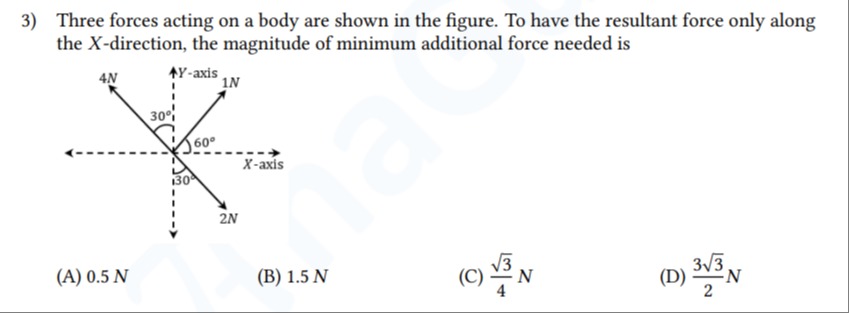Question
Question: Three forces acting on a body are shown in the figure. To have the resultant force only along the X-...
Three forces acting on a body are shown in the figure. To have the resultant force only along the X-direction, the magnitude of minimum additional force needed is

0.5 N
1.5 N
43 N
233 N
(D) 233 N
Solution
To determine the magnitude of the minimum additional force needed to have the resultant force only along the X-direction, we need to ensure that the net Y-component of all forces (initial three forces plus the additional force) is zero. The minimum additional force will be one that has only a Y-component and no X-component, as any X-component would only increase its magnitude without contributing to cancelling the Y-component.
Let's resolve each of the three given forces into their X and Y components. We will use the convention that angles are measured from the nearest axis, and assign signs based on the quadrant.
-
Force of 1 N:
- It is in the first quadrant, making an angle of 60° with the positive X-axis.
- Y-component: F1y=1sin(60∘)=1×23=23 N
-
Force of 4 N:
- It is in the second quadrant, making an angle of 30° with the positive Y-axis.
- Y-component: F4y=4cos(30∘)=4×23=23 N
- (Its X-component would be −4sin(30∘))
-
Force of 2 N:
- It is in the fourth quadrant, making an angle of 30° with the negative Y-axis.
- Y-component: F2y=−2cos(30∘)=−2×23=−3 N
- (Its X-component would be 2sin(30∘))
Now, let's find the resultant Y-component (Ry) of these three forces:
Ry=F1y+F4y+F2y
Ry=23+23−3
Ry=23+3
To sum these, find a common denominator:
Ry=23+223=23+23=233 N
To have the resultant force only along the X-direction, the total Y-component must be zero. Let the additional force be Fadd. Its Y-component must cancel out Ry.
So, Fadd,y=−Ry=−233 N.
The magnitude of the minimum additional force needed is the magnitude of this Y-component, as its X-component must be zero for the force to be minimum.
Magnitude of minimum additional force =∣−233∣ N =233 N.
